
My dear friend Shun, as I affectionately call her, shared this dish with me many moons ago, and I was hooked after my first try. Fideos (noodles) are a simple symphony of spicy, smoky and fresh flavors. It is sometimes called sopa de fideos, which translates to dry noodle soup.
It makes for a great side dish, but I often eat it as a main course. Traditionally, it is served with crema fresca (creme fraiche), queso fresco and avocado. A great option for a meat-free menu, and delicious to boot. Another plus, it is prepared in a jiffy or rápidito! I made this batch at the last minute to take to a party and was unable to find tomatoes that were ripe enough, so I opted for good canned ones. Likewise, I had no luck in the avocado front, so no avocados for me! You decide how much heat you want and adjust the number of serranos accordingly, you may also remove the seeds, this will further reduce the heat level.
Fideos a la Shun
12 oz fideo pasta or angel hair
4 tbsp olive oil
1 medium onion
2 garlic cloves, whole
1 or 2 serrano peppers, to taste
5 fresh Roma tomatoes, ripened OR
1 can (15 oz.) stewed tomatoes
2 tbsp chicken flavor bouillon (like Knorr or Maggi)
Water
1/2 tsp dried oregano
1/2 tsp cumin powder
Salt and pepper to taste
For plating:
Queso fresco, crumbled
Crema fresca
Avocado slices or small cubes
I would suggested getting the sauce ready first. Shun’s recipe calls for the onion, garlic, serranos and fresh tomatoes to be roasted first. You can skip this step, but it does add an intensity and complexity to the dish, so if you have the time–about 10-15 extra minutes–you should do it.

I use my comal or grill pan for this, getting it nice and hot, then sear the sliced onion, whole serranos, garlic and tomatoes (fresh). Once seared, dump the whole thing into your blender or food processor, adding the chicken bouillon, cumin, oregano, salt & pepper and enough water to get things moving. Set aside.
Heat a large saute pan over high heat add the oil and break the pasta into it, the purpose of this step is to toast the pasta, but don’t walk away, it burns rather quickly and that will ruin the flavor of the dish. The noodles will change color and turn golden brown.
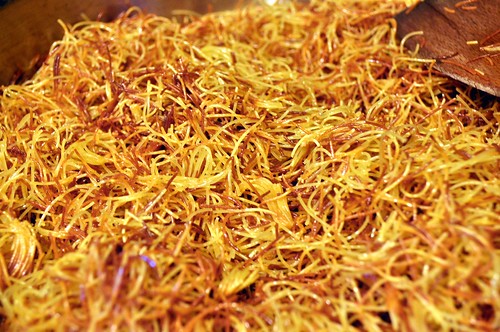
Carefully, VERY carefully add the pureed sauce and watch yourself! It becomes the evil spitty monster at this point, add enough water to ensure the noodles are submerged in liquid. Lower the heat so it simmers gently, check the seasoning and adjust as necessary.
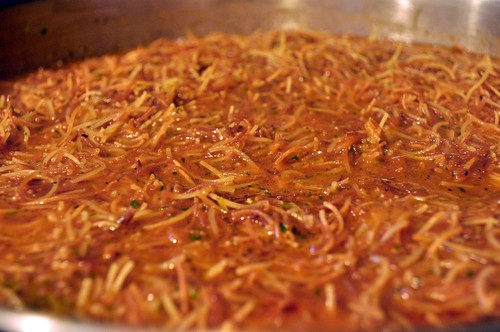
The noodles should be al dente, when done. It will take about 20 minutes for the pasta to cook and you may need to add more water as it cooks down. To plate: spoon some noodles onto a plate, top with crema, avocado and the crumbled cheese. Pull up a chair and enjoy!

To see more of the step-by-step process, click here.
Cookingly yours,
Anamaris
PS: Thanks, Shuni!
The Hubbz hates the use of the word ‘juxtapose’, he says it has become all trendy and overused. I laugh every time I hear the word and look at the disgust on his face as he rolls his little blue eyes. That said, this dish is a perfect juxtaposition of flavors. Creamy, tart, spicy, hot, and a cooling sweetness. Perfect! Just pair it with a Margarita and you have the makings of an excellent 5 de mayo celebration.

Puerco en Salsa Verde (pork in green sauce) is a very popular Mexican dish that marries chiles and tomatillos with pork meat, usually the shoulder. You’ll find a few variations, with or without corn and at various degrees of heat = picante. One element that is always present, is that zingy tang of the tomatillos.
To contrast, or juxtapose, the tang, I added a radish and red pepper raita–of sorts. Raita is an Indian or Pakistani sauce or condiment, usually prepared with yogurt, cucumbers and various herbs. My version, with a Latin flavor, used crema fresca instead of the yogurt and some colorful Easter radishes and red peppers. This made for a deliciously fresh, cool and ever so slightly sweet topping for the tomatillo and chile sauce. It is juxtaposition perfection and tastes GOOD!
Pork in Green Sauce with Radish and Crema Fresca Raita
For the pork:
1 lb pork shoulder or butt, cubed
3 tbsp vegetable oil
1 large onion, sliced
3 garlic cloves, whole
6-8 tomatillos
1-2 serrano peppers (to taste)
1 tbsp cumin, ground
1 tbsp oregano
1 tsp salt
1 tsp black pepper
1 cp onion, chopped
2 cps fresh corn, shucked
1/2 cp cilantro, chopped
I like roasting tomatillos, this intensifies their flavors and brings out more rounded aspects of the fruit. Spread them on a baking sheet with the onion slices, serranos and garlic cloves, and broil them for 15 to 20 minutes, turning them as they brown.
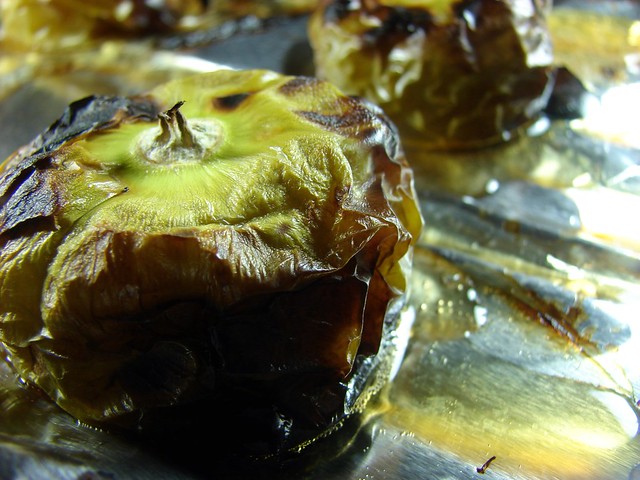
Once browned, dump the whole thing (there will be plenty of juices from the tomatillos) into a blender vessel and puree with the cumin, oregano, salt & pepper. Set aside.
In the meantime, season the pork with salt & pepper; in a medium-sized pan, heat the oil and then brown the pork pieces. Remove the excess fat from the pan, leaving enough to saute the extra cup of onions. Once the onions become translucent, add the pork, followed by the pureed tomatillo & pepper sauce.
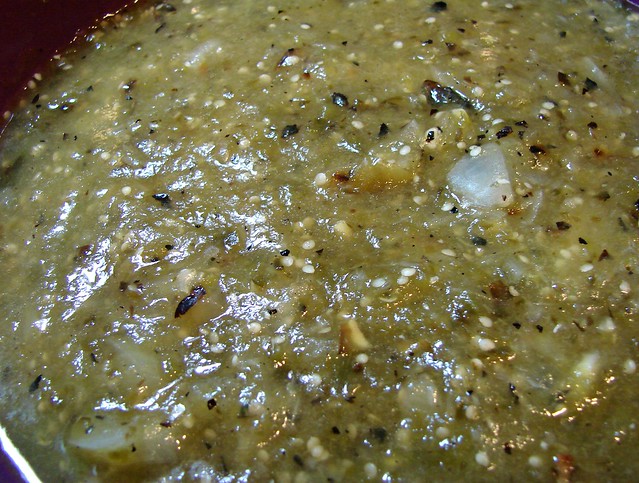
If necessary, add enough water to ensure there’s enough liquid to cover the pork. Once it comes to a boil, bring the temperature to low, just so it is slowly simmering. Put a lid over it and allow it to simmer for about an hour or until the pork is tender.
Once the pork is fork tender, add the corn and cilantro, check the seasoning and adjust as necessary. Allow it to cook for another 5 minutes or so, just long enough for the corn to soften. To serve, top with some radish raita and enjoy!

For the Radish and Red Pepper Raita
1 cp radishes, julienned
1/4 cp red bell pepper, chopped
1/2 cp crema fresca (creme fraiche)
Salt & pepper to taste
2 tbsp cilantro, finely chopped
Combine all the ingredients and keep cool until ready to serve.
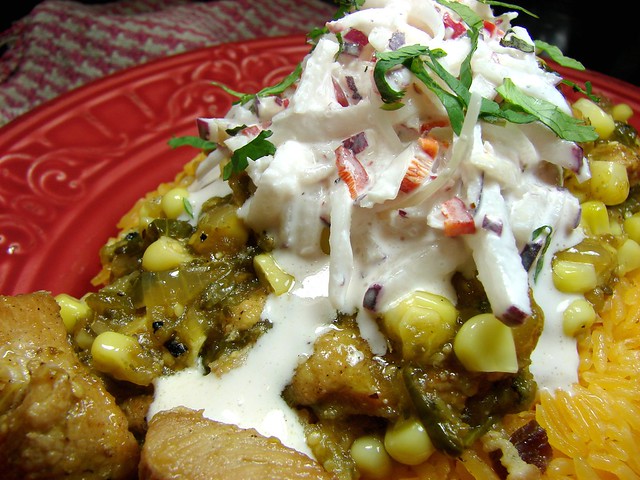
Where’s my Margarita?!!
Cookingly yours,
Anamaris
Even though Mexican food is readily available in Houston, that doesn’t mean you get good tamales. For years I enjoyed the Rolls Royce of tamales, but most restaurants here serve tamales that are closer to a Yugo. My ex-mother-in-law made the best tamales I’ve eaten to date. She made them every year and would give each of her sons a few dozens to enjoy. I cherished those days, they only came around once or twice a year, so I had a lot of time to think and dream about them. Alicia was a generous woman, but she kept her method and recipe for tamales very close to the vest. Fast forward some 15 years, you’ll find me trying my hand at recreating the coveted tamales.

Off to the interworld I went looking for recipes and tips. I found lots and lots of them, all calling for chili powder as seasoning. For some reason, I can’t picture my mother in law dumping chili powder to season her pork or chicken. So, I’m going to make this up as I go, combine some of the ingredients I saw her utilize in other dishes and see what happens. It all begins with the chilies. I used 3 different dried chiles:
- Chile Ancho is pretty mild by comparison to other dried peppers, it has a smoky fruity flavor. This isn’t surprising when you realize that Anchos are dried red poblano peppers.
- Chile Guajillo also a mildly flavored chile, that seems to bring out the best in its companions. Fruity, but with sweeter undertones than other peppers. Interestingly, guajillos are also used to make Harissa paste, a condiment popular in North African dishes.
- Chile Pasilla are very dark and wrinkled like a raisin, they’re also pretty mild heat & fruity.
I used all three chilies a few different ways. First, to braise the pork and chicken. Yes. I made 2 different types of tamales, I had to. Both meats were cooked separately and slowly with onions, garlic, cumin, cilantro and 1 or 2 of each chili. I made sure to add plenty of water for braising, because that very broth flavors the masa later. Once the meat is fork tender, I allowed it cool before shredding.

I also made additional chili sauce. One thing I remember about Alicia’s tamales, is that the dough was always very flavorful and colorful. For the chili sauce, I cooked the same aromatics: cilantro, chilies, onions, garlic, cumin and added tomatoes. Once everything had softened, I pureed and seasoned the sauce.

Now let’s talk about the masa. I opted to use premixed masa instead of starting off with the dry corn stuff. But first I made lard. Yep, there’s a LOT of lard in tamales. The lard helps flavor the masa and makes it lighter, fluffier. So, I got some pork fat trimmings and rendered that fat down.
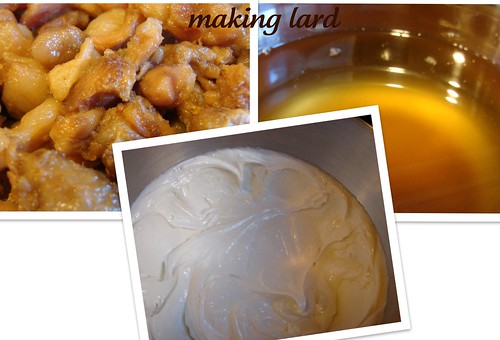
Before combining the lard and masa, I beat the lard until it was fluffy and added salt, pepper and pinch of cumin. I then worked the masa in and worked on its consistency by adding chile sauce and broth until it was about the consistency of softened ice cream.
The tamales are cooked in corn husks, these are sold in packs and need to be rehydrated before use. Once they are pliable again, you can begin the exciting task of stuffing or making the tamales. Its not a difficult process, but it is a tedious one, which is probably why it is customary to have a few friends or family members pitch in at this point.
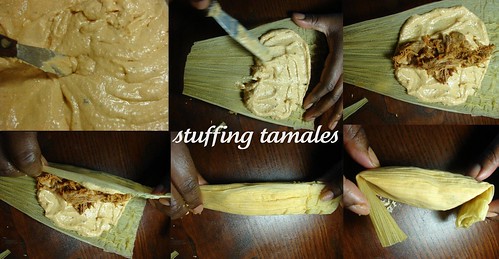
Once your tamales are stuffed, you can stack’em into a steamer pan. I took a vegetable steamer and placed it at the bottom of the pan, built a few layers with empty corn husks, this prevents the water from seeping through and ruining the tamales at the bottom and it also add to the flavor of finished tamales.

After about 40 minutes, you’ll end up with perfectly cooked, delicious tamales. Look at that gorgeous baby.

I also made some salsa and we sprinkled some queso fresco on top. I’m not offering a recipe here, I really kept adding and tasting things until they were right. I will say these weren’t quite Rolls Royce tamales, but I think I made it to Benz status.

There are lots more pictures, you can see them here.
Cookingly yours,
Anamaris
It’s cold in Houston. Like freezing cold. As much as I love the cold, it makes very, what’s the word…? Lazy. Yep. I’ve got a ton of already prepared, shot and eaten dishes to tell you about, but with all the real work I’ve been doing, I’ve not been able to sit before the puter to type ‘em up.
So, we’re going to the mattresses. I mean, the archives. This is what I do when I’ve not had a chance to come up with a new post and when I think there’s something yummy you may have missed in my early days.
This one is really good, it is a creamy and spicy chicken dish with Mexican flair. This is Pollo con Crema Poblana (Chicken with Poblano Cream Sauce). For the recipe, click the link.

Lazily yours,
Anamaris
Yesterday I introduced you to Lesley of Mija Chronicles fame. She’s an expat living in Mexico City and she loves food, particularly that of the Mexican persuasion. She posted this recipe for Pan de Elote just a few weeks ago, I made it the day I read it. I’m sure that gives you a good indication of how fantastic it is. I’m SO happy I made this. My waistline isn’t happy, well, I don’t think my waistline cares one way or the other. The mirror…, that’s a different story.
Moving on. I will redirect you to her post for the actual recipe, no need to re-invent the wheel. Believe me, you WANT to see her post. You may actually want to EAT her post, but I don’t think computer monitors will taste quite the same. A few notes about the recipe and the steps to bring it together.

Her recipe was made with white corn, which is commonly available in Mexico, but I wasn’t able to find it here in Houston. The best I was able to get was 2-color fresh corn, but still, it was mostly yellow.
I was 1 ear of corn shy of 4 cups of husked corn kernels. Upon closer inspection, I only had 3 cps. Gulp. Unwilling to take such a massive risk, and because The Hubbz will always make an emergency run for me, I asked him to get me more cobs. Crisis averted.

Because I suck at following recipes, I missed the part where it said to grind HALF of the corn…, you should do that.
I did use the unsalted butter, but added a pinch of salt for that ying yang effect. I would also suggest using a bit less of the sugar since the US corn tends to be so sweet.

For this recipe you will beat the egg whites to punto de turrón or to soft peaks for the non-Spanish speakers. Check it out, I’m holding that bowl over my head.

And you want to fold these beautiful whites into the rest of the batter without losing all that cloudy fluff. So, take just a bit of the whites and mix them into the batter, then fold in the rest of the whites. This will make folding the two together easier and more uniform.
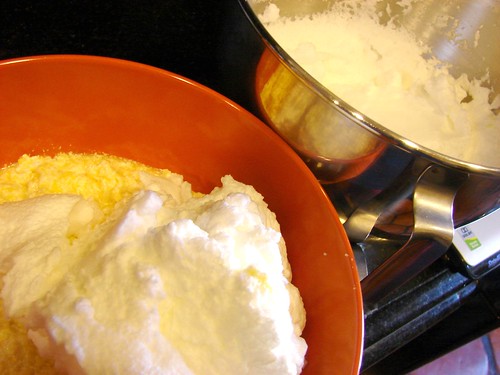
And when it baked for 55 minutes or so, it came out looking like this. Can you hear the choir? Aaaaaaaaaaaaah…

The Hubbz and I ate this in 2 days. I’m not proud of it, but this is about full disclosure. This isn’t cornbread as we know it here in the US, it’s not even the cakier version of it. This is a cross between a souffle and an angel food cake. Lesley describes it as a buttery corn cake, and it is all of those things. We especially enjoyed this cake with a bit of queso fresco sprinkled over the top. Ying Yang, baby.

Another keeper!
Cookingly yours,
Anamaris
You can find the original recipe to this delicious mole on Rick Bayless’ site or, as I did, on this cookbook. The full version of the recipe includes all the peppers that need to be roasted, rehydrated and blended. I took a shortcut here. Instead of using the various peppers (chiles), I went for a prepared, store-bought mole under the assumption that it would include said peppers. I know. There are a few Mexican grandmothers turning in their graves as I type this. My only hope is that they don’t read English and maybe won’t understand the extent of my trespass. Move on.
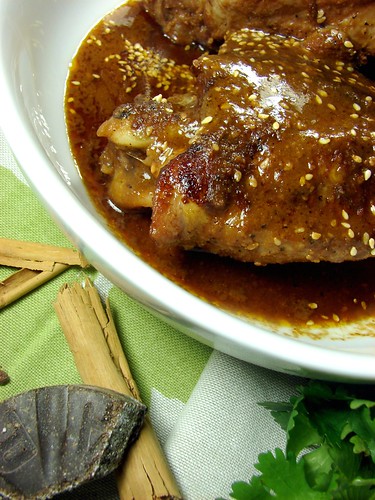
I suppose my shortcut doesn’t allow me to judge the true tastes of the original recipe, but I can tell you that shortcut or no, this recipe rocks! This stuff is so delicious, I considered bathing in it. OK, I know you don’t need that graphic ingrained to your brain. My bad. Anyway, this would be awesome on chicken, pork, seafood, coffee, cookies, eh er…

Turkey in Red Mole Sauce (adapted from Mexico – One Plate at a Time)
makes about 10-12 cups of sauce
5 medium tomatillos, husked and rinsed
1/2 cp sesame seeds
1/2 cp rich pork lard or vegetable oil (I used bacon fat)
4 garlic cloves, peeled
1/2 cp unskinned almonds
1/2 cp raisins
1/2 tsp cinnamon, (use ground Mexican canela if available)
1/4 tsp black pepper, freshly ground
1/4 tsp anise
1/8 tsp cloves
1 cp pre-packaged mole sauce
1 slice firm white bread, darkly toasted and broken into several pieces
1 oz (about 1/3 of a 3.3-ounce tablet) Mexican chocolate, roughly chopped
Salt
4 – 5 tbsp sugar
4 turkey thighs with skin & bones (approx 4lbs)
And now, for the steps:
Roast the tomatillos under a very hot broiler until splotchy black and thoroughly soft, about 5 minutes per side. Scrape into a large bowl.

In a dry skillet over medium heat, toast the sesame seeds, stirring nearly constantly, until golden, about 5 minutes. Scrape half of them in with the tomatillos. Reserve the remainder for sprinkling on the turkey.
In a heavy-bottom pot or dutch over or Mexican cazuela, if you have one of those, heat the bacon fat over medium heat and fry the garlic and almonds, stirring regularly, until browned (the garlic should be soft), about 5 minutes. With a slotted spoon, remove to the tomatillo bowl, draining as much fat as possible back into the pot.
Add the raisins to the hot pot. Stir for 20 or 30 seconds, until they’ve puffed and browned slightly. Scoop them out, draining as much fat as possible back into the pot, and add to the tomatillos. Set the pan aside off the heat.

To the tomatillo mixture, add the cinnamon, black pepper, anise, cloves, bread, mole sauce and chocolate. Add 2 cups water and stir to combine.
In two batches, blend the tomatillo mixture as smoothly as possible (you may need an extra 1/2 cup water to keep everything moving through the blades), then strain it into a bowl and set aside.
If you’re using uncooked turkey, this is when you will season the turkey with salt & pepper. Raise the temperature on the pan to medium-high and brown the thighs on all sides, this will take about 10 minutes. If you make the mole sauce ahead, you can move on to braising the thighs in the sauce. If you are still working on the sauce, go ahead and put the turkey in the fridge while the sauce gets ready.
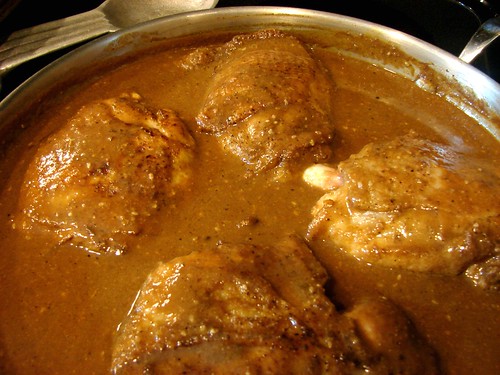
Pour out any excess fat, you only need enough to leave a film on the bottom of the pan. Add the blended tomatillo mixture and cook, stirring every few minutes until considerably darker and thicker, 15 to 20 minutes. You’re looking for the sauce to become the consistency of tomato paste. A word to the wise, use a spatter screen, this mole business is very spitty.
Add 6 cups of water to the pot and briskly simmer the mixture over medium to medium-low heat for 45 minutes for all the flavors to come together and mellow. If the mole has thickened beyond the consistency of a cream soup, stir in a little water. Taste and season with salt and sugar.
Heat the oven to 325°. Lay the turkey in the mole, cover with a lid or foil and place in the oven. Cook until the thighs internal temperature registers 150, this will take about 40-55 minutes. Remove the turkey from the sauce and allow it to rest for a few minutes. Serve with generous amounts of mole sauce.
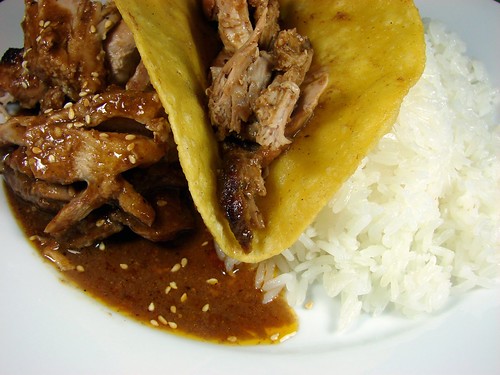
Check out the green mole here and for the rest of the mole porn shots, click here.
Cookingly yours,
Anamaris
This is the fresh mole, that’s what I’m calling it because of A tangy, tomatillo-based sauce, thickened with toasted pumpkin seeds, it’s served with everything from chicken to fish and seafood.
Again, the recipe is based on Rick Bayless’ book, Mexico-One Plate at a Time, I only substituted turkey for chicken. The recipe is pretty straightforward, though there are a few steps to follow. As with the recipe for red mole, you can substitute uncooked turkey with your cooked leftovers. Simply prepare the sauce to completion, then add the cooked meat to heat through.
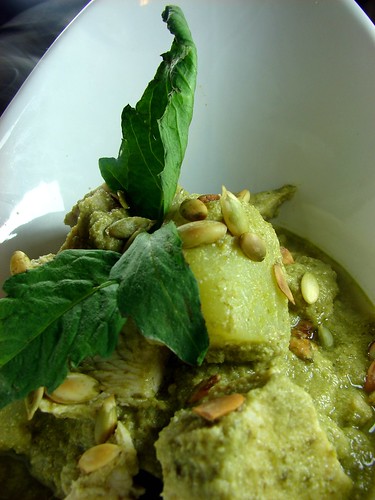
Pavo en Pipián Verde
1 turkey breast or 4 thighs (about 4lbs)
1 small white onion, sliced, divided use
4 garlic cloves, peeled and halved, divided use
1/2 tsp each dried marjoram and thyme
3 bay leaves
Salt to taste
1-1/4 cps hulled, untoasted pumpkin seeds
5-6 medium tomatillos, husked, rinsed and roughly chopped
2 large romaine lettuce leaves, torn into large pieces
2 serranos or 1 jalapeño, stemmed, roughly chopped
Leaves from a small sprig of epazote, plus an additional sprig for garnish
1/2 cp loosely packed chopped cilantro, plus a few sprigs for garnish
1-1/2 tbsp vegetable oil or olive oil
2 medium chayotes
2 medium zucchini
Poach the turkey: In a stock pan, add 10 cups water, half onion, 2 garlic cloves, marjoram, thyme, bay leaves and about 1-1/2 teaspoons salt. Bring to boil. Add the turkey, reduce heat to simmer. Simmer uncovered over medium heat for 20 minutes. Cover pot and let stand off heat for another 30 minutes. Remove turkey from pot. Strain broth and skim off fat that rises to top (can be done 1 day ahead).
Prepare sauce: In a saucepan, Dutch oven or cazuela (a traditional Mexican earthenware casserole with a lid), dry-toast pumpkin seeds. Set pot over medium heat, add the seeds and, when the first seed pops, stir constantly until all have popped from flat to round, about 5 minutes. Don’t let them darken past golden or the sauce will be brownish and slightly bitter. Cool. Set aside 3 tablespoons for garnish and transfer rest to blender.

Add remaining onion and garlic to blender, along with tomatillos, lettuce, chiles, epazote leaves and chopped cilantro. Pour in 1 cup of strained broth; cover and blend to smooth puree (can be done 1 day ahead).
 In In the same pot you toasted the seeds, heat oil over medium-high heat. When hot enough to make a drop of puree sizzle sharply, add it all at once. Stir as mixture darkens slightly and thickens considerably, about 10 minutes. Stir in 2 more cups broth, reduce heat to medium-low and simmer about 20 minutes for flavors to mellow and sauce to thicken to medium consistency (it should coat spoon). Be careful, this is another spitty sauce.
In In the same pot you toasted the seeds, heat oil over medium-high heat. When hot enough to make a drop of puree sizzle sharply, add it all at once. Stir as mixture darkens slightly and thickens considerably, about 10 minutes. Stir in 2 more cups broth, reduce heat to medium-low and simmer about 20 minutes for flavors to mellow and sauce to thicken to medium consistency (it should coat spoon). Be careful, this is another spitty sauce.
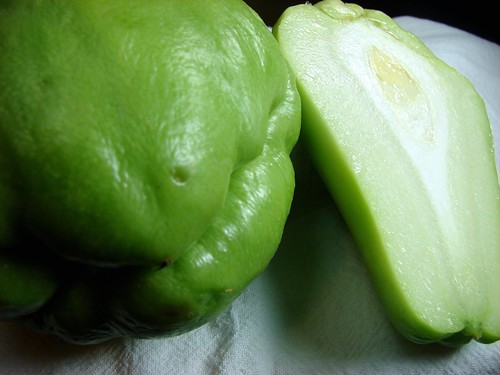
While sauce is simmering, prepare the veggies. Peel the chayote and remove the seed. You may want to do this under running water as chayote has a sap that will stick to your hands and make them turn black. Cube the chayote after peeled, then blanch the vegetables in salted boiling water, cooking chayote about 3 minutes, then adding zucchini for 1 minute. Drain and spread vegetables on plate to stop cooking.
When sauce has simmered 20 minutes, it will likely look coarse. Smooth it to a velvety texture by reblending it in small batches (loosely covered to avoid blender explosions). Return sauce to pan, taste and season with salt, if needed, about 3/4 teaspoon. If sauce has thickened beyond a light cream-sauce consistency, thin it with a little remaining broth.
Remove skin from cooked turkey, if desired, cube and slip into sauce, then add cooked vegetables. Simmer over medium heat just long enough to heat everything, about 5 minutes, then spoon turkey, vegetables and sauce out onto warm serving platter. Sprinkle with reserved pumpkin seeds (you may want to crush them), decorate with sprigs of epazote and cilantro.

For the full mole action, check out the photostream.
Cookingly yours,
Anamaris
I’ve never made mole before. Not really. I wanted to share these recipes with you so you’d have something to work with for Turkey’s Day After. It’s impossible to avoid having 100 lbs of leftover turkey and you can only eat so many sandwiches.
Let me try to describe the flavors of these dishes to you and do them justice. I’ll start by saying they’re similar in the complexity of flavors, at once surprising and familiar. Yet, they’re also in perfect contrast to each other.
Red mole seemed to have an inherent nuttiness that reminded me of peanut butter and the slightly bitter sweetness of chocolate. There’s smokiness that makes you wonder if this is a sauce that was developed from an old roux. It is rich and spicy, not in term of heat but flavor. Yet, it doesn’t taste like 5 different spices, they’re not individually identifiable, but you can tell they’ve come together to bring out the best in each other.

On the other hand, the pipián sauce or green mole tasted light and vibrant, with a nice pungent bite. The lightness of it seeming to fight against the creaminess of the sauce. I’m not sure how to explain it, other than to say it tasted as though we were eating something rich and decadent, while knowing nothing heavy or rich was added.

I’m not going to lie and say these are easy recipes, but they were not too difficult either. Scratch that. They’re not difficult at all, what they are is involved. Lots of steps, which is why I cheated a bit. We have 2 versions of the traditional Mexican sauce: Turkey in Mole Rojo and Turkey in Pipián Verde (green mole).
These recipes come from Bayless’ cookbook, Mexico – One Plate At A Time, and you’ll notice there is at least one other post in the last few days that was inspired by the book. Check out the Green Beans & Carrots in Escabeche. They are incredibly delicious.
A couple of side notes:
- The website recipe is for a very large batch, it’s actually doubled the one in the book. I don’t think you’re feeding a small army, so I’m offering the book version. I had enough sauce to save about 4-6 cps for later use.
- Bayless calls for a whole boneless turkey breast (uncooked). Since I’m not a breast fan, I went with thighs and kept the bones in the mix.
- If you are making this with leftover turkey, simply add the cooked meat once the sauce has reduced.
- I have an old, kick-ass blender that can puree almost anything to a pulp. This is to say I skipped the straining part, you may need to strain it if your blender doesn’t do as well and/or if you have issues with tidbits of sesame seeds.
- Use an oven-safe pan or dutch oven. You will cook on the stove and finish it in the oven.
Are you ready for this? Check out the recipe posts, Turkey in Red Mole and Turkey in Pumpkin Seed Sauce.
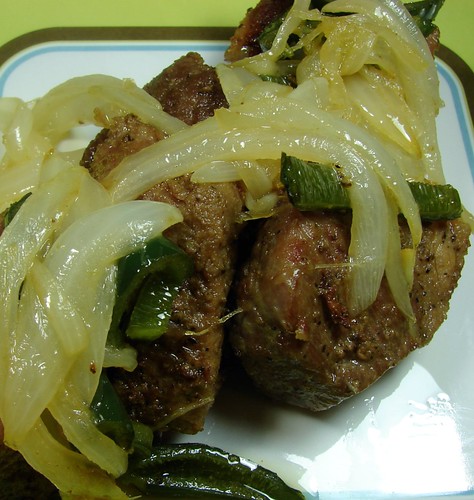
Sort of, but not exactly. See, confit is a French cooking and preservation method. The idea is to salt and flavor meats that are then slowly cooked in their own fat (or added fat) and later preserved in said fat. Carnitas are not preserved in the fat, though I don’t see any reason why they couldn’t be, except for the fact that they wouldn’t last that long at the Price household.
I’ve had incredibly beautiful and delicious duck confit in Paris. They usually use the leg and thigh portions of the duck because these are fattier cuts. When they bring it out, the duck skin is slightly crisp and glistening, almost see-through. The meat is super tender and flavorful, enhancing the duck’s earthiness to the umpteenth degree. It is very aromatic, you can pick up the scents of garlic, thyme, sometimes ginger and clove.
Similarly, carnitas are made with a fatty cut of pork, most often a butt or shoulder roast. It is seasoned and slowly cooked in its own fat. The resulting meat is fall-apart tender and flavorful. Some places will serve it slightly crisped and topped with grilled onions and peppers.
There are many reasons I love making these at home. It’s super cheap: pork butt/shoulder roasts can usually be found for as low as $1/lb. It’s incredibly easy to make: once the pork is sliced, there’s very little fussing about. It feeds an army and works well as an entrée, a taco, or pretty much anything you can dream up. And finally, I love pork. Do you need more reasons?

Of course, there are hundreds, if not thousands of versions and recipes. But I find that the simpler, the better and over the years I’ve come to figure out how I like ‘em. I use just a few aromatics and pre-mixed fajita seasoning. If you can’t find the fajita seasoning, just use equal parts salt, black pepper and garlic powder. Here’s my super secret recipe…, yah. not really.
Carnitas (little pieces of meat)
1 Pork butt or shoulder roast, boneless (about 5lbs)
2 tsp fajita seasoning
1 tsp cumin powder
1 tsp oregano
2 yellow onions, sliced
1 poblano pepper, seeded & sliced
1 tbsp olive oil

Cut the roast into pieces that are about 1-inch thick and season with the next 3 ingredients (don’t discard too much of the fat). Place the seasoned in a dutch oven or heavy-bottom pan, trying to keep it on a single layer. Add about 1 cp of water, just enough to have it come up around the pork, but not necessarily cover it.
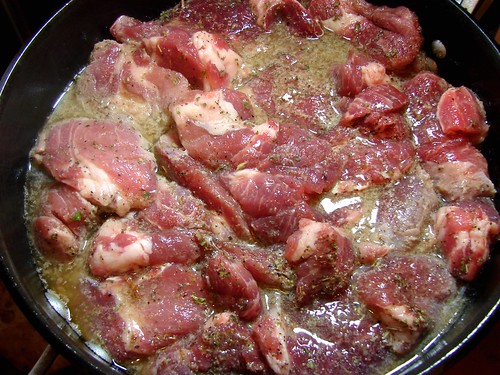
Cover the pan with a tight-fitting lid and bring to a simmer over medium-low heat. It will simmer for about 45 minutes before the liquid evaporates and it begins to render the fat. At this point, remove the lid, lower the temperature and begin to brown the pieces of pork. Turning them a few times for the next 15-20 minutes.
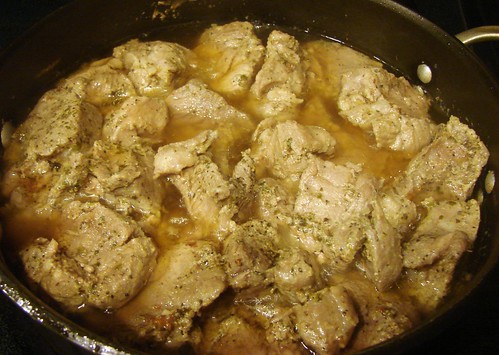
You can cook cook the onions and peppers in a separate saute pan, just until softened. Serve with tortillas, rice and/or beans.

Cookingly yours,
Anamaris
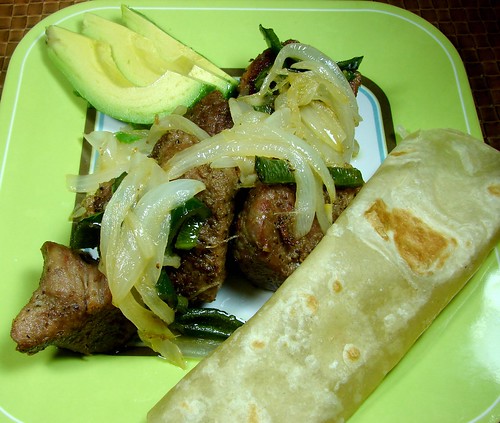
I think its funny how there are months for everything, but I’m not going to lie and say I don’t enjoy the ones devoted to food. Well, unless it happens to be a food I don’t enjoy, like bananas. A little birdie told me October is National Chili month; I have to guess it’s due to the first visages of Fall (for most of the US states), temperatures begin to drop and people begin to crave hearty stews. Again, my guess.

Living in Houston, I’ve come to understand people here and all over the state of Texas are big on the whole chili thing. There are festivals and cook-offs celebrated throughout the Fall, aimed at finding the best recipe. There are as may variations to chili recipes as there are people in Texas, but one thing I’ve come to learn is that real Texas chili does not include beans.
MY chili isn’t so much chili as it is Chile con Carne. Not Texan, probably not Mexican, but the variation I learned from my mom. Another difference here, is that more often than not, in Texas chili is served with cornbread. My version tastes best atop a heap of perfectly cooked white rice. I made it for The Hubbz not long ago and he loved it AND he’s a native Houstonian! So there must be something good there.
As with all stews, aging is a virtue. The taste will improve and intensify every day after you make it. So why not give it a whirl?
Mi Chile con Carne
2 lbs ground chuck (80/20)
2 cps white onion, diced
Fresh serrano peppers, finely diced
2 cloves garlic, crushed
1 tsp cumin powder
1-1/2 tsp Italian seasoning
3 cps red or pinto beans, cooked
2-3 cps beef broth
Sea salt & black pepper
Notes:
- I don’t use a very lean ground beef for this, you won’t add any fat and you need some to cook the onions and develop some flavor.
- If I have the time and/or forethought, I will cook my own beans with 1 clove garlic and bay leaf, then use the cooking liquid instead of adding broth. I have used canned beans as often as I’ve used fresh, but I do rinse my canned beans and discard the canned liquid.
- You decide how hot you want it, add as many or as few serranos as you’d like.

Heat a large pan over high temperature and add the beef, breaking it apart as you drop it. You can leave it in marble-sized clumps as it cooks; add the garlic, cumin and Italian seasoning at this time. The liquid from the beef will sweat out, as it evaporates, the fat will be left behind and you’ll be able to brown the beef.
Lower the temperature to medium high and add the onions and serrano peppers. Continue cooking until the onions have softened and become translucent.
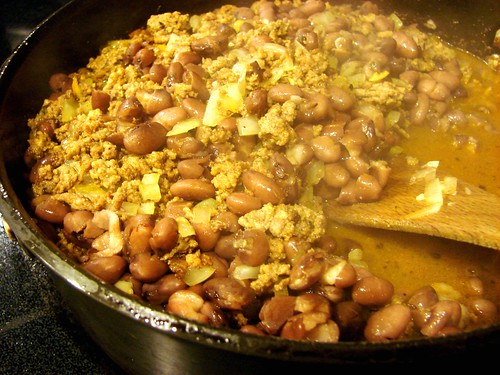
Add the beans and scrape off the goodness stuck to the bottom of the pan. Then add the broth or liquid from the beans, enough to cover the beef. Adjust seasoning with salt & pepper as necessary, but keep in mind that the saltiness will intensify as it simmers. Lower the temperature to low, cover and allow it to simmer for about 40 minutes, stirring it every so often.
Serve over white rice and top with sour cream and/or cheese.

¡Buen provecho!
Cookingly yours,
Anamaris















































